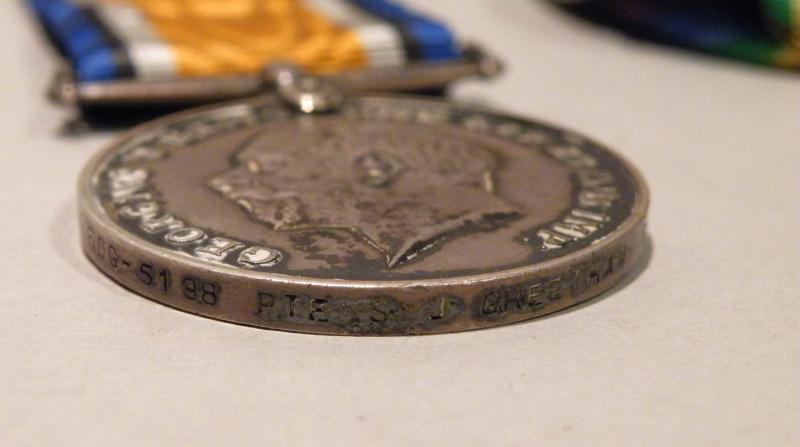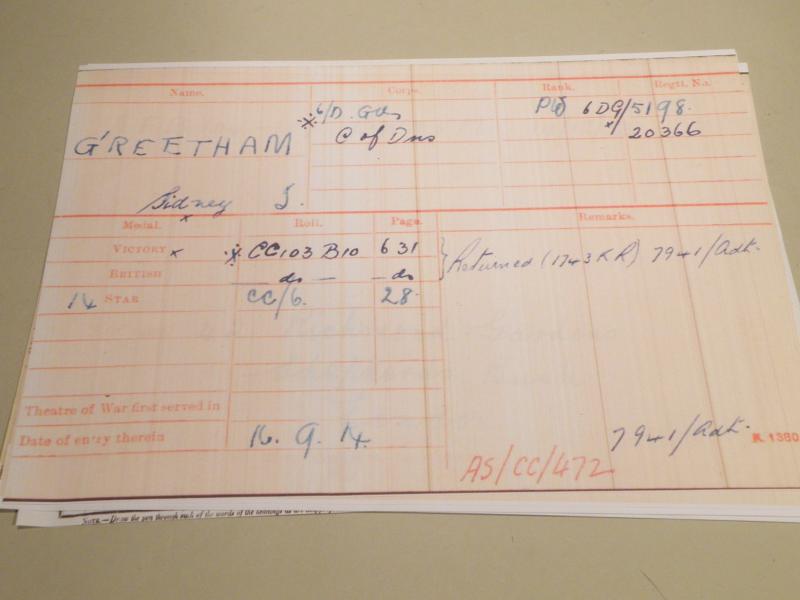1914 Star Trio to Greetham 6th Dragoon Guards Carabiniers.
1914 star, British war and victory medal all correctly named, star to 5198 Pte S. J. Greetham 6 D Gds. War and victory medal to 6DG-5198 Pte S. J. Greetham 6 D Gds.
Pte Sidney J Greetham was born in Bedford on 29th March 1887. He worked for a time in London as a Barman when he was just 16, but as war loomed, he returned home to Bedford, living with his widowed mother Elizabeth, his Brother Arthur and Sister Dora, taking a job as a house Painter.
On the outbreak of war he enlisted into the 6th Dragoon Guards, part of the part of 4th Cavalry Brigade in 2nd Cavalry Division, being transferred on 14th October 1914 to bring it up to the standard three brigade strength. It remained with the division on the Western Front until the end of the war, Sidney Greetham arriving in France on the 16th September 1914.
In 1914, the brigade, with the division, took part in First Battle of Ypres, notably the battle of Gheluvelt, 29th to 31st October. On 11th November, the Household Cavalry Composite Regiment was broken up and its constituent squadrons rejoined their parent regiments. The 1/1st Queen's Own Oxfordshire Hussars, a Yeomanry regiment, joined in its place.
In 1915, the division was in action at the Battle of Neuve Chapelle on the 10th–12th March 1915, and the Second Battle of Ypres, notably the Battle of St Julien on 26th April–3rd May and the Battle of Bellewaarde Ridge 24th–25th May.
1916 saw no notable actions, but in 1917 the division saw action in the Battle of Arras (First Battle of the Scarpe and the Battle of Cambrai including the Tank Attack of 20th – 21st November,and a few days later, the Capture of Bourlon Wood and the subsequent German Counter-Attack of 30th November to the 3rd December. At other times, the brigade formed a dismounted unit and served in the trenches as an infantry regiment.
1918 saw the return of the war of movement and the division took part in the First Battle of the Somme notably the Battle of St Quentin (21–23 March), the Battle of the Lys (Battle of Hazebrouck of 14–15 April), the Battle of Amiens (8–11 August) and the Second Battle of the Somme (Battle of Albert of 21–23 August and the Second Battle of Bapaume of 31 August–3 September).
The division was then split up with the 4th Cavalry Brigade serving with Third Army. The brigade took part in the battles of the Hindenburg Line, notably the Battle of the Canal du Nord (27 September–1 October) and the Pursuit to the Selle (9–12 October). Its final action was to take part in the Advance in Picardy (17 October–11 November) including the Battle of the Sambre (4 November), still with Third Army.
At the Armistice, the brigade had reached Erquelinnes with Third Army. On 15 November, the division was re-assembled near Maubeuge and ordered to advance into Germany as an advance screen for Fourth Army and form part of the Occupation Force. The move began on 17 November, Ciney and Rochefort were reached five days later.
In late December, the division moved to winter quarters south and south-east of Liège. It remained here until 30 January 1919 when it exchanged regiments with 1st and 3rd Cavalry Divisions then gradually moved back to England. The Division ceased to exist at midnight 31 March / 1 April 1919, and the 6th DG was later to merge with the with the 3rd Dragoon Guards (Prince of Wales's) to form the 3rd/6th Dragoon Guards. Sidney finally being discharged on 1st May 1919.
It looks like Sidney enjoyed a good long life, in the 1939 register he is a caretaker of residential flats in Epsom and Ewell, Surrey. Sadly, Sidney died on the 29th September 1953 in St Pancras Hospital in London.
All three medals are in excellent condition and they comes with various pages of research including a copy of his medal index card, medal roll and census information.
Code: 30276
145.00 GBP








